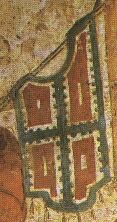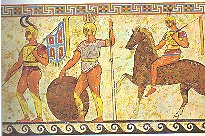 image
contributed by Thomas Robinson, 29 May 2000
image
contributed by Thomas Robinson, 29 May 2000
Last modified: 2021-08-24 by rob raeside
Keywords: italy | samnite people | paestrum |
Links: FOTW homepage |
search |
disclaimer and copyright |
write us |
mirrors
 image
contributed by Thomas Robinson, 29 May 2000
image
contributed by Thomas Robinson, 29 May 2000
See also:
A banner was used by the Samnite people, who lived in the
south of Italy at the time of Rome's ascension. They fought a
number of wars with the City of Rome, between 343 BC and 290 BC
before the Romans finally conquered them. They actually had a
chance to destroy Rome when they defeated the Roman forces in 321
BC, but the Romans outmaneuvered them and built up their strength
until they defeated the last Samnite city in 290 BC. Small-scale
attacks by Samnite peoples in the hills continued until about 80
BC.
As regards the item in question: I don't know whether it should
be counted a flag or not. Flags, as such, were not really around
at that time, but this is definitely a piece of (more or less)
rectangular fabric hung from an upright staff and would be called
a flag by most people. It has a distinctive pattern on it, in
three colours, and was commonly used by one or more Samnite
cities. It does not actually connect with the pole for its whole
length; there is a semi-circle missing in the centre.
Above is a small scanned picture of it, taken from a photo of a
Roman fresco in a warriors tomb in Paestrum. It is being carried
on a pole slung over the shoulder of a Samnite soldier.
Thomas Robinson, 29 May 2000
There are two images of Samnite flags in Znamierowski's
'Encyclopedia of flags'. He does name them flags but seeing the
form I wouldn't know what else to call them
Jarig Bakker, 29 May 2000
Jostein Nygård asked: Is this the actual shape of
the flag, or is it just depiction of a heavy cloth that would
form a 'natural' bulge?
I believe that the actual shape of the flag is roughly
rectangular, and that the distortion is just the artist's attempt
to make it seem more natural, yes.
Thomas Robinson, 29 May 2000
This flag is precisely the one shown on page 11 of
Znamierowski's "World Encyclopedia of Flags". It is
indeed a fresco, which kind of surprised me, for two reasons: (1)
I had thought fresco was a late Medieval or Renaissance technique
and (2) the flag suggests a cross, such symbolism being jolly
unlikely in 330 BC
Al Kirsch, 29 May 2000
I suspect it's not a cross, just the same pattern repeated
four times
Roy Stilling, 29 May 2000
I think it's the actual shape. I seem to recall that these are supposed
to have been made from leather, and they were fixed to the pole
only at the top and the bottom. The extremities of the animal
hide? The edges around each quarter aren't squares or rectangles,
but rather follow the outline of the cloth. In this case, it's
not a cross, but the combination of the edges of each of the four
"quarters".
Peter Hans van den Muijzenberg, 3 June 2000
It appears to most scholars that have studied this fresco that
what is shown is no flag at all but simply a tunic of a defeated
foe hanged on a pole as a trophy.
Sources:
- Peter Connolly : Hannibal against Rome
- John Warry : Greece and Rome at War
- Duncan Head : Armies of the Macedonian and Punic Wars, WRG
Publication.
Sorry, it would have been a nice ancestor to modern flags, but
I'm positive that this piece of cloth matches really well with
what we know of male warriors dress style in central Italy of that
time...
Philippe Bondurand, 25 May 2001
The image of the fresco clearly illustrates *one* side of the
"tunic/flag" (either back or front) and *not* a side
view. If the illustrated item was a tunic the wearer's left
shoulder would be at least 20cm higher than their right!
Furthermore Roman artists knew how to accurately illustrate the
fold of fabrics in a naturalistic manner; the item in question
does not hang
naturalistically, which indicates either that it is not in fact a
tunic - or else it was more important for the design on the
"tunic/flag" to be recognised by viewers of the fresco
than to represent the item itself naturalistically.
George Cruickshank, 25 May 2001
Yes but....
1) The author of the drawing is not a Roman, the fresco is taken
from a Samnite burial.
2) The fresco is much larger then the part depicted on the site
and shows many other un-naturalistic details.
3) AFAIK, vexilloids of the time were tied to cross-bars. If
someone knows about a piece of fabric attached to un upright pole
at that time, I would be delighted to hear of. I'd love to be
wrong on that topic, really.
4) The holder of the so-called "flag" is walking in
front of another soldier holding what seems to be the belt of the
tunic on a similar pole.
5) You are right to stress the point that to be recognised by the
viewer is more important then accuracy. The fact that another
soldier follows closely the tunic-bearer explains that the artist
have bent the tunic in such unrealistic way from the pole. To let
room enough for the next soldier.
Philippe Bondurand, 25 May 2001
I believe that the fresco is depicting a banner. It was common
to Italics to have banners and vexilloids at the time and Sanniti
were well organized troops that gave a lot of troubles to Romans.
It would be surprising to see one of them depicted in a Roman
fresco with a tunic taken from a foe (i.e. a Roman) as a symbol
of (Roman) defeat. Much more probable that the painter wished to
show Sanniti with one of their symbols. That is not an ancestor
of modern national flags, but for sure our army colours descend
from those times (and earlier).
Pier Paolo Lugli, 25 May 2001
Well, it looks like this is probably the case, then. I was the
one who first submitted the image, based upon what I read, but my
references only mentioned the subject in passing, not with any
detail. It could well be that it was a defeated enemy's tunic. I
am hardly an expert on that sort of thing (my interest in the
Romans and their neighbours is based more in the late Republic
and early Imperial periods). I don't have immediate access to any
of the sources mentioned, but I see no reason to doubt this new
explanation.
Thomas Robinson, 25 May 2001
If it is a tunic, it appears to be a peculiarly
(deliberately?) lop-sided one.
George Cruickshank, 25 May 2001
 image located
by Philippe Bondurand, 25 May 2001
image located
by Philippe Bondurand, 25 May 2001
Belts are clearly visible, both on the same pole and on the
javelin carried by the cavalryman. Reviewing my sources I must
admitted that Peter Connolly, in Hannibal and The Enemies of
Rome believes that it's a standard. But: 1) he is alone in his
opinion. 2) his book has many errors regarding interpretation of
archaeological evidences, including Carthaginian phalangists with
sarissae (12 feet pikes Macedonian style) which is grossly wrong,
Carthaginian phalanx is attested with much smaller spears 5 to 6
feet tall.3) The other sources are more recent and better
documented in all topics related.
Philippe Bondurand, 25 May 2001
The semi-circular "hole" where the fabric is
attached to the pole is simply the collar, the two parts that are
attached are the shoulders. The sides of the tunic were higher
then the front and back to allow easier movement, for the same
reasons modern close-fitting shirts are often cut-open down the
sides. This explains the rounded "fly" of the makeshift
"flag". Looking once more to my sources, I found the
one of the main reasons to think its a tunic. Looking carefully
to the main size illustration at :
<www.geocities.com/phenixia120/samnites.jpg>
you'll see tassels at the shoulders of the tunic of the second
warrior. The same kind of tassels are present on the shoulder of
the tunic hanged on the pole. Now look at all the 3 tunics, they
are all rounded in front, the same way that the tunic hanged.
Then look at the belts, they are the same color as the belt
hanged. Once again, I would really love this to be a flag. But it
is not. Maybe the first banner once was born like this? That is
all we can say.
Philippe Bondurand, 25 May 2001
I'm an archaeologist at the institute of archaeology,
university college London. My research is on the military and
cultural significance of the south Italic warriors panoply. The
illustration you have posted on your site is from a tomb fresco
from Nola dated to 330-320 BC and is currently exhibited at the
Museo Campana in Capua Vetere. I have had the opportunity to
examine this painting firsthand and I'm afraid it is not a flag
at all. The illustration shows a trophy taken from a defeated
enemy, in this case it is a tunic and a bronze belt (not visible
in your picture) They are suspended by two javelins which the
warrior carries over his shoulder. There is another warrior on
horseback in this fresco who carries a trophy of only a belt. The
warrior with a tunic over his shoulder as a trophy is a popular
iconographic image among the south Italic peoples (Samnites,
Campanians, Lucanians) and is often misinterpreted as a flag or
standard as it appears similar both visually and contextually to
our modern concept. The practice of stripping enemy warriors of
their tunics, belts and other items of equipment is a custom
related to single combat and the strong heroic ethos this
perpetuated. The closest the south Italic peoples would have to a
flag at this period would probably be something along the lines
of the Roman aquila or eagle standard. A metal, usually bronze
image of an animal on a pole. In fact, at the same museum in
Capua Vetere there is a bronze cockerel from the sanctuary of
Pietrabbondante which is believed to be from a standard.
I have a recently published article on this subject which
discusses the confusion of these trophies with flags. It is
'Visible proofs of valour: The trophy in south Italic iconography
of the 4th century BC' in Papers from the Institute of
Archaeology 14 (2003): 42-56. London.
Note: An abstract of the paper can be found at
www.ucl.ac.uk.
Mike Burns, 15 January 2004